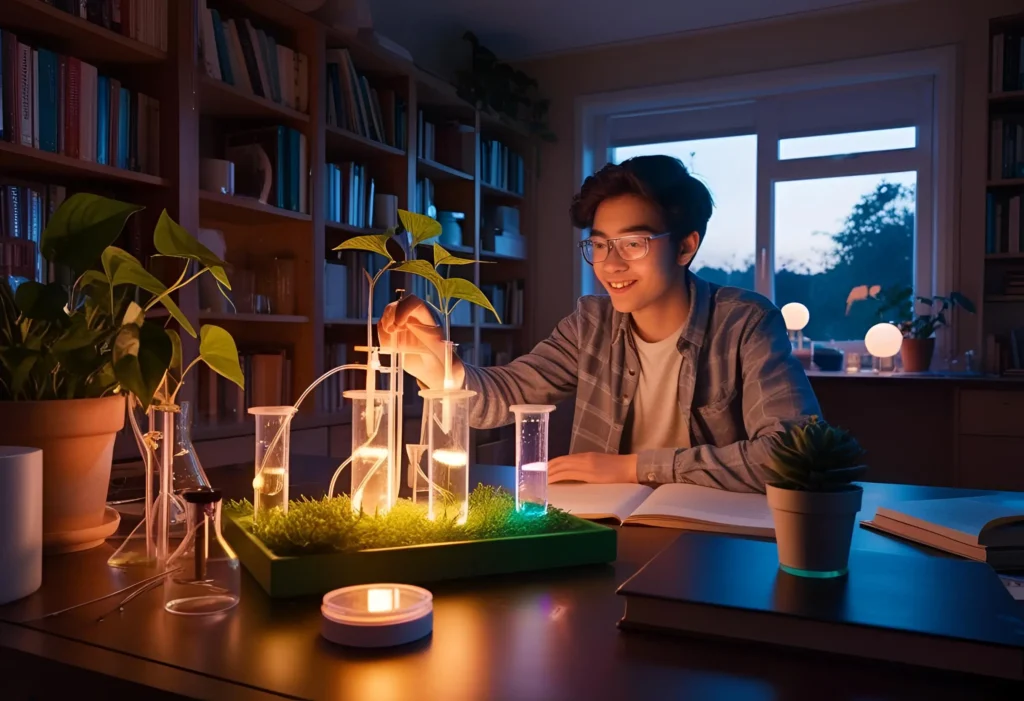- Input 🔬
- What Is Quantum Biology? 🧬⚛️
- Quantum Biology Experiments That Can Be Done At Home 🏠🔍
- 🛒🧰Necessary materials and preparation
- The process and methodology of the experiment 🔬📊
- 📸📝Observation and data collection
- The Analysis Of The Results 🔍📈
- Results and discussion 🧠💭
- Frequently Asked Questions ❓🤔
- 1. A really scientific field of quantum biology?
- 2. Quantum experiments at home can really show effects?
- 3. Which plants are most suitable for this experiment?
- 4. How quantum imaging can be explained by the effect on plant growth?
- 5. Agricultural practices can influence the results of these experiments?
- Bibliography 📚📑
Input 🔬
Quantum biology, and is one of the most exciting areas of modern science, are of great interest in recent years. Quantum mechanics this article examines the impact on biological systems through experiments that can be done at home. Especially the growth performance of plants and quantum entanglement but focusing on the relationship between, and application methods of scientific research in this field, we will consider.
Today, quantum theory and biological systems interactions, has emerged as a new scientific field. Plants, light energy photosynthesis into chemical energy through the process of converting, it is believed that play an important role in quantum mechanics. This article experiments that can be applied easily at home with this impressive area, it will help you to discover. 🌿⚛️
What Is Quantum Biology? 🧬⚛️
Quantum biologyis an interdisciplinary science that applies the principles of quantum mechanics and biological systems. This field examines how biological processes at the molecular level is affected by the quantum effects.
The Basic Concepts Of Quantum Biology:
- But quantum entanglement: when two or more threads, have to interact with each other regardless of the distance between them
- Tunnel effect: Particles classical physics the energy barrier that will not allow to be able to pass
- Superposition: the particles can be found in more than one quantum state at the same time
- Quantum coherence: a quantum system can interact with its environment, although they retain the properties of the quantum
These concepts, DNA replication, enzyme activity, photosynthesis , and even bird navigation , such as biological processes are increasingly being used to describe.
Table Of Quantum Effects In Biological Systems
| Biyolojik Süreç | İlgili Kuantum Etkisi | Etki Mekanizması |
|---|---|---|
| Photosynthesis | Quantum coherence | More energy-efficient light transport |
| Enzyme Activity | Tunnel effect | The transition of the energy barrier of the proton |
| DNA mutation | Tunnel effect | Tautomerik slip between the base pairs |
| Bird Navigation | But quantum entanglement | Earths magnetic field detection |
| Plant Growth | But quantum entanglement | Communication and coordination between cells |
Quantum Biology Experiments That Can Be Done At Home 🏠🔍
Quantum biology may seem complex, although some basic concepts for understanding simple experiments you can do at home. In these experiments, conducted in a laboratory environment are simplified versions of the professional.
1. 🌱Seed Experiment Pairs👯♂️
In this experiment, quantum entanglement, but of the concept is to observe the potential effects on plant growth.
Hypothesis: taken from the same plant and seed pairs held together for a while, even after they split up may exhibit similar growth characteristics.
2. Quantum Randomness Experiment 🎲🌿
In this experiment aims to examine the effect on plant growth of the sources of quantum randomness.
Hypothesis: according to the number of sources of randomness obtained from plants irrigated Quantum to classical randomness may exhibit different growth characteristics according to sources.
3. 💡The Experiment, The Polarization Of Light🔄
This experiment examines the effect of polarized light on plant growth.
Hypothesis: Different angles of polarization can exhibit growth characteristics of plants grown under different light.
🛒🧰Necessary materials and preparation
In the house, you will need the following ingredients to make experiments on quantum biology:
Basic Ingredients:
- Pairs from the same plant the seed (at least 20 pairs)
- October pots or containers (40 pieces)
- Soil quality
- Sprayer water
- Ruler (millimetre-scale)
- Notepad or a table of data records
- Digital camera (daily for a photo shoot)
- Polarizing filters (polarization of light for the experiment)
- LED light sources
Special Ingredients:
- Quantum random number generator (online resources can be accessed from: ANU Quantum random number generator)
- Light intensity meter (optional)
- Humidity meter
- Temperature gauge
Preparation Phase:
- Seed selection: fast-growing plants to select (eg. beans, lentils, grass)
- Media control: temperature, humidity, and lighting conditions hold as steady as possible
- Labeling: All the experimental groups according to label the pots
- Create a table of data: Daily prepare a table for measurements
The process and methodology of the experiment 🔬📊
The Methodology Of The Experiment, Seed Pairs:
- Double tag and keep the seeds for 24 hours in the same container, 20 each pair
- Then, separate each pair, and the attachments in separate pots
- Flowerpot a room with a groupB group-room or otherplace to eat
- All plants give the same amount of water and light
- Daily growth measurements
The Quantum Randomness Of The Experiment Methodology:
- 20 plants to divide them into two groups
- For the first group, using a random number generator to select the time and amount of irrigation classical
- For the second group, using a random number generator to select the time and amount of irrigation quantum
- Daily growth measurements
The Methodology Of The Experiment, The Polarization Of Light:
- Divide into four groups of 20 plants
- Different angles of polarization light with grow under each group(0°, 45°, 90°, 135°)
- Hold all the other conditions constant
- Daily growth measurements
📸📝Observation and data collection
Regular and detailed data collection is critical for the success of the experiments. Measure and record the following parameters on a daily basis:
- The plant height (in MM)
- Number of leaves
- Leaf width (in MM)
- Root Length (end of experiment)
- Plant color (standard color using the card)
- Sap thickness (in MM)
Sample Data Collection Table
| Gün | Bitki ID | Grup | Yükseklik (mm) | Yaprak Sayısı | Yaprak Genişliği (mm) | Notlar |
|---|---|---|---|---|---|---|
| 1 | A1 | Control | 5 | 2 | 3 | Normal growth |
| 1 | B1 | Quantum | 5 | 2 | 3 | Normal growth |
| 2 | A1 | Control | 7 | 2 | 4 | Normal growth |
| 2 | B1 | Quantum | 8 | 2 | 5 | Rapid growth |
| … | … | … | … | … | … | … |
Also, create a visual record of taking pictures of the plants daily. This will be valuable for future analyses.
The Analysis Of The Results 🔍📈
To analyze the collected data, you can use the following methods:
1. Comparison Of The Growth Rate
Calculate and compare the average growth rate of the plants in each group. The growth rate can be calculated as the height change daily.
Growth Rate = (Final Height, The First Height) / Number Of Days 2. Statistical Analysis
To determine whether the differences between groups are statistically significant, t-test or apply statistical tests such as Anova.
3. Graphical Analysis
To visualize the data, line and bar graphs. These allow you to more easily see trends and patterns.
Sample Comparison Chart Growth
High (mm)
^
| * (Kuantum)
| *
| *
| *
| * o (Control)
| * o
| * o
| * o
| * o
+---------------------------------> Day
1 2 3 4 5 6 7 8 9 10
Results and discussion 🧠💭
Results obtained from experiments, but quantum entanglement, quantum randomness , and the polarization of light may indicate that quantum effects such as the potential effects on plant growth. Although the results are different than expected, this is a natural part of the scientific process.
Possible Results:
- Pairs of seed: seed Entangled pairs, separate environments may exhibit similar growth characteristics
- Quantum randomness: Quantum randomness irrigated using plants, may show rapid growth or more regular
- Polarization of light: a specific polarization angles, can increase the efficiency of photosynthesis
Limitations and future research:
- It is important to provide precisely controlled conditions in the home environment
- Results should be verified in a laboratory with sophisticated equipment more professional
- Larger sample sizes and long-term experiments, may provide more reliable results
Frequently Asked Questions ❓🤔
1. A really scientific field of quantum biology?
Yes, quantum biology is an interdisciplinary field of scientific research centers surveyed growing and reputable. In particular, studies on quantum coherence in the process of photosynthesis, the legitimacy of this field has increased.
2. Quantum experiments at home can really show effects?
Experiments in the home environment, although is not as precise as they are made in professional laboratories, may be sufficient to demonstrate the basic principles of quantum effects. These experiments are for educational purposes can be a source of inspiration for further research and more.
3. Which plants are most suitable for this experiment?
Fast growing plants that can be grown easily and is sensitive to changes is the best. Beans, lentils, grass, arugula , and nursery plants such as are ideal.
4. How quantum imaging can be explained by the effect on plant growth?
Although it is still a subject of research, some theories suggest that quantum coherence can improve the coordination between cells in the growth process. I kriptokro that exhibit quantum behavior of proteins in plant cells, it is believed.
5. Agricultural practices can influence the results of these experiments?
In the long term, quantum increase the yield of plant biology research, disease resistance, improve, and may offer new ways to improve sustainable agricultural practices.
Bibliography 📚📑
- Al-Khalili, J., & McFadden, J. (2014). Life on the edge: the coming of age of quantum Biology. Crown Publishing Group. Link
- Lambert, N., Chen, Y. N., Cheng, Y. C., Li, C. M., Chen, G. Y., & Nori, F. (2013). Quantum biology. Nature Physics, 9(1), 10-18. DOI: 10.1038/nphys2474
- Engel, G. S., Calhoun, T. R., Read, E. L., Ahn, T. K., Mancal, T., Cheng, Y. C., … & Fleming, G. R. (2007). For evidence of Energy Transfer through quantum coherence in photosynthetic systems wavelik. Nature, 446(7137), 782-786. DOI: 10.1038/nature05678
- Huelga, S. F. & Plenio, M. B. (2013). Vibrations, quanta and biology. Contemporary Physics, 54(4), 181-207. DOI: 10.1080/00405000.2013.829687
- Romero, E., Augulis, R., Novoderezhki, V. I., Ferretti, M., Thieme, J., Zigmantas, D., & Van In Grondel, R. (2014). Quantum coherence in photosynthesis for efficient solar-energy conversion. Nature Physics, 10(9), 676-682. DOI: 10.1038/nphys3017
- Brookes, J. C. (2017). Quantum effects in biology: enzymes in the golden rule, olfaction, photosynthesis and magnetodetection. Proceedings of the Royal Society a: mathematical, physical and engineering sciences, 473(2201), 20160822. DOI: 10.1098/rspa.2016.0822
- Marais, A., Adams, B., Ringsmuth, A. K., Ferretti, M., Gruber, J. M., Hendrikx, R., … & van Grondel R. (2018). The future of quantum biology. Journal of the Royal Society Interface, 15(148), 20180640. DOI: 10.1098/rsif.2018.0640
- ANU Quantum random numbers Server. https://qrng.anu.edu.au/
- Quantum biology laboratory at the University of Surrey. https://www.surrey.ac.uk/quantum-biology-doctoral-training-centre
- Cao, J., Cogdell, R. J., Coker, D. F., Duan, H. G., Hauer, J., Kleinekathofer, U., … & Miller, R. D. (2020). Quantum biology revisited. Science Advances, 6(14), eaaz4888. DOI: 10.1126/sciadv.aaz4888
This article and understand the basic concepts of quantum biology by conducting simple experiments at home this engaging science is intended for those who want to explore. The article is for informational purposes only and does not replace professional scientific research.
© 2025 Science Experiments At Home. All rights reserved.




